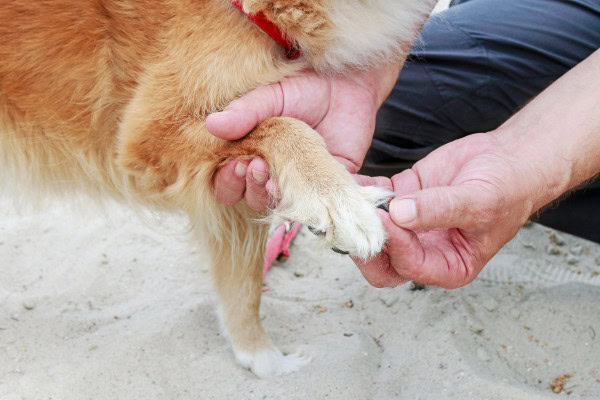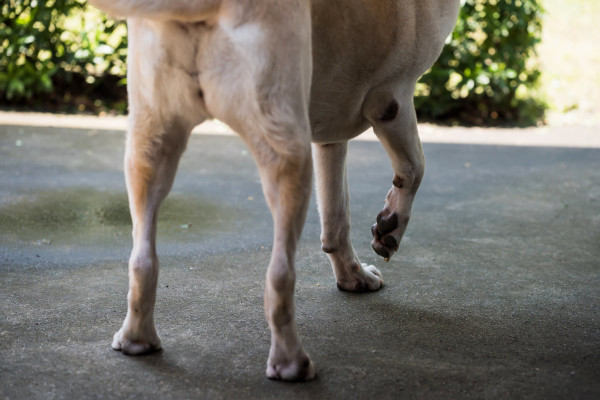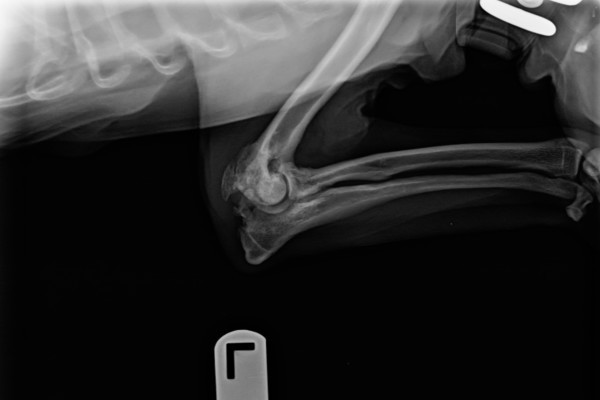If your dog is limping on a front leg, you may be wondering what is causing the limp and when you need to head to the vet. If so, this article is for you! Integrative veterinarian Dr. Julie Buzby invites rehabilitation veterinarian Angela Youello VMD, PhD, CCRT, CVA to discuss 10 reasons for a dog limping on a front leg. Learn what to do should you find yourself in this situation.

Anytime you notice your dog limping, it’s normal to be worried. Reluctance to put as much weight (or any weight) on a leg is usually a sign of pain or discomfort in dogs, even if you aren’t seeing any other changes. In fact, limping is often the only symptom we may see when our furry friends are experiencing musculoskeletal pain.
Dogs can limp on a front leg or a back leg, or even both at the same time! There are many possible reasons for your dog to limp, and each can affect your dog’s well-being and mobility in different ways.
What causes limping on a front leg in dogs?
When a dog is limping on a front leg, often an injury to the paw is assumed to be the cause since the paw is the weight-bearing surface of the leg. However, the carpus (i.e. wrist), elbow, or shoulder are all equally at risk of being the culprit.
Some causes of limping occur suddenly and have an obvious event (such as a fall) that led to the injury. Other conditions develop more gradually. And without a known triggering event, it can be hard to figure out why your dog is limping. Likewise, some issues are minor and resolve themselves, while others are more serious and require medical attention.
When do I need to go to the vet?
Remember, if your dog is limping for over 24 hours, it’s crucial to seek veterinary care. Your veterinarian can examine your dog’s legs and feet to pinpoint the cause of the lameness, determine necessary tests, and decide on appropriate treatments.
Until your vet visit, keep your dog on one level of your home. And limit his or her activity to prevent worsening of any potential injury.
If the limping is mild, is not worsening, and there are no obvious complications like cuts or foreign material in the skin, you should schedule an appointment with your veterinarian within 24 to 48 hours. However, if the limping is severe or accompanied by injuries like cuts, head to the ER for an emergency vet visit instead of waiting to get in with your regular vet.
Why is my dog suddenly limping on a front leg?
First, let’s talk about some possible reasons for your furry friend to suddenly start limping on a front leg. Then we can get to some of the conditions that cause gradual limping on a front leg instead.
Common causes of sudden front leg lameness include:
- Injury to a paw pad
- Broken or injured nail
- Bone fractures
- Tick-borne illnesses
- Neck injury causing pain to radiate down the front leg
- Muscle strain or connective tissue sprain
1. Injury to a paw pad
Paw pad injuries in dogs can range from subtle to clear-cut. Sometimes, your dog may suddenly yelp and start limping. And you can see an obvious cut on their paw pad. Other times, a dog might step on something tiny that causes pain but isn’t visible upon a quick look.
Often, protecting the injured foot by wrapping your dog’s paw can lead to a smooth recovery. However, severe injuries, like lacerations or embedded objects, might require surgical intervention.
2. Broken or injured nail

A dog may rip a nail off or a dog may split a nail, leading to pain and limping. The damage can be clear, like a nail that’s completely fallen off or is bleeding. Or it may be less noticeable, such as a tiny crack causing pain but not visible to the naked eye.
Fortunately, with proper pain relief and foot protection, these injuries typically heal in a few weeks. However, given that nails constantly touch various surfaces, they’re prone to infections. Keep an eye on your dog’s foot for signs of infection like redness, swelling, discharge, or increasing pain during recovery.
3. Bone fractures
If you saw your dog suffer an injury or trauma, your dog might have broken bones or a dislocated joint. These injuries can occur due to falls during activities (e.g. climbing stairs), jumping off furniture, or playful collisions. Even a misstep in the dark can result in injuries like broken toes in dogs.
If your dog suddenly refuses to bear weight on a leg following such an incident, a break or dislocation may be to blame. A veterinary exam and X-rays can usually diagnose the issue. Treatment varies with your dog’s age, the affected bone or joint, and the injury type. Sometimes, support through splinting, bandaging, and rest suffices, but severe cases may require surgery.
4. Tick-borne illnesses
Tick borne diseases in dogs such as Lyme disease in dogs can cause a dog to start limping. Any leg can be affected, and sometimes the lameness shifts from one leg to another, making it harder to diagnose. Blood tests are available for the most common types of tick-borne illness. And thankfully, most dogs will recover well with antibiotics and nonsteroidal anti-inflammatories (NSAIDs).
5. Neck IVDD or other neck injury
Neck injuries in dogs can lead to pain that radiates down one of their front legs and causes lameness. Similar to humans, dogs have a compressible disc in between each pair of vertebrae in their spinal column. Intervertebral disc disease (IVDD in dogs) can cause these discs to become inflamed and put pressure on the spinal cord or the nerves that exit the spinal cord. This causes pain and other problems. If the affected disc is in the neck, the pain can radiate down one of the front legs, leading to limping.

Sometimes it is possible to treat IVDD in dogs without surgery. NSAIDs, muscle relaxants (e.g. methocarbamol for dogs), strict cage rest, and weight management can help resolve some neck injuries. However, more serious cases require IVDD surgery for dogs.
6. Soft tissue injuries (sprains or strains)
Soft tissue injuries like muscle strains or sprains (i.e. damage to ligaments connecting bones) are common in dogs but hard to pinpoint. Since these injuries usually don’t appear on X-rays, a vet might diagnose a strain or sprain if there’s leg pain without changes to the bones or joints on X-rays.
Soft tissue injuries can cause pain, swelling, and difficulty in weight-bearing. Fortunately, they often improve with rest, pain relief, and sometimes physical therapy for more serious cases. For joint instability from a sprain, a brace might be necessary during healing. Or the vet may recommend surgical treatment if the injury doesn’t heal with rest and medication.
Why did my dog gradually start limping on a front leg?
However, for other dogs, the limping starts gradually or just happens on and off. And then over time it may get worse or more consistent.
Some common causes of gradual-onset or intermittent limping on a front leg include:
- Arthritis
- Elbow dysplasia
- Osteosarcoma
- Immune-mediated polyarthritis (IMPA)
1. Arthritis
Osteoarthritis in dogs is a very common cause of gradual-onset limping in dogs. It is a form of joint disease caused by inflammation that leads to degradation of cartilage. In normal, healthy joints, viscous fluid lubricates the moving surfaces and cartilage cushions the underlying bone.
But in arthritic joints, inflammation causes the joint fluid to become thinner and less lubricating, which leads to cartilage wear and tear. Eventually, bony changes occur in the joints that cause more pain, inflammation, and decreased range of motion.
A classic sign of arthritis in dogs is stiffness and discomfort upon waking up or after resting that improves with movement. And the limping tends to be worse in the winter since arthritic joints often hurt more in cold or damp conditions.
Managing arthritis in dogs
There are a range of treatments for relieving arthritis pain in dogs. To support cartilage health, your vet might recommend injections of Adequan for dogs or giving your dog joint supplements for dogs like omega-3 fatty acids, glucosamine, and chondroitin (all found in Dr. Buzby’s Encore Mobility™ hip and joint supplement, for example). And if your dog is slipping on the floor, a dog traction device such as Dr. Buzby’s ToeGrips® dog nail grips can be helpful.

Pain management is a mainstay of arthritis treatment in dogs. NSAIDs such as carprofen for dogs effectively reduce pain and inflammation. And dogs who can’t take NSAIDs may benefit from different pain medications like gabapentin for dogs. Plus, acupuncture for dogs can offer additional pain relief.
Your vet might also recommend physical therapy (i.e. rehabilitation therapy), which can alleviate pain and help reduce the risk of compensatory injuries. Some potential rehabilitation modalities include:
- Hydrotherapy (e.g. underwater treadmill for dogs and swimming) to maintain muscle mass while reducing impact on arthritic joints
- Laser therapy for dogs to reduce pain and inflammation
- Exercises designed to maintain muscle strength and range of motion
As arthritis is chronic, ongoing management focusing on weight management, cartilage health, and pain relief is crucial for your dog’s quality of life.
2. Elbow dysplasia
You have probably heard of hip dysplasia in dogs, where malformation of the hip joint leads to pain and lameness. Elbow dysplasia is not quite as well-known, but is one of the most common causes of elbow pain in dogs. It is an inherited condition that occurs when the elbow joint does not form properly. Elbow dysplasia can affect one or both elbows, and is more common in large and giant-breed dogs.
Dogs with one affected elbow may have a “head bobbing” lameness that is more obvious as they land more heavily on the “good” leg. In other dogs, dysplasia affects both elbows, and there may not be obvious lameness, but rather a shortened stride.
Dogs with severe elbow dysplasia may be diagnosed as puppies if their joint malformation interferes with the elbow’s normal range of motion. But dogs with mild elbow dysplasia are often not diagnosed until they develop arthritis in middle age.
For all dogs with any type of joint malformation or disease, maintaining a healthy weight is extremely important to reduce strain on affected joints. And as with other causes of arthritis, using joint supplements and pain relief, plus physical therapy to strengthen muscles and manage secondary issues, can ease discomfort. For severe cases, surgery may improve mobility and reduce pain even later in life.
3. Osteosarcoma
Osteosarcoma in dogs, a rarer lameness cause, is a type of cancer arising from abnormal cells in the bone. It usually affects the long bones of the legs. In the front legs, osteosarcoma tends to occur in the upper part of the humerus (i.e. upper arm bone) near the shoulder and the lower part of the radius (i.e. forearm bone) near the carpus (i.e. wrist). Osteosarcoma is typically very painful and causes pronounced lameness, often accompanied by firm swelling of the affected area.

Treatment typically involves a dog leg amputation followed by chemotherapy. But your vet can help guide the decision about what is right for your dog.
4. Immune-mediated polyarthritis (IMPA)
Like tick-borne disease, immune mediated poly arthritis (IMPA) can cause lameness in one or more joints. Dogs with IMPA often have other signs of illness as well, which isn’t the case for most other causes of lameness we talked about. Fever, decreased appetite, being a lethargic dog, and GI upset are all common in dogs with IMPA.
Your veterinarian may need to perform a variety of tests to arrive at a diagnosis. Many dogs with IMPA receive a physical exam, blood tests for dogs, and X-rays. And if those tests don’t reveal an underlying cause for the lameness, the dog may need arthrocentesis for dogs. This is also known as a “joint tap”, and involves collecting samples of joint fluid to look for abnormal cells and infectious organisms.
The treatment for IMPA involves immunosuppressive medications. So a thorough workup is important to make sure no other factors are contributing to the lameness.
Work with your vet to determine why your dog is limping on a front leg
It’s crucial to remember that limping typically indicates pain, even if your dog seems fine otherwise. Dogs don’t usually cry out in pain and might continue with their normal routines, like eating and playing. This makes lameness a key sign of discomfort. Some dogs are very stoic and won’t even limp on a painful leg. But you may see more subtle signs of pain such as reluctance to play, difficulty getting up from rest, or unwillingness to go on walks of a usual length.
You know your dog better than anyone. And if you ever have a feeling that something may not be right, it’s safest to see your veterinarian for a thorough physical exam. For sudden, severe limping, it’s best to get immediate veterinary help, which may mean seeing an emergency vet. If your dog’s limp is mild or worsens over time, schedule an appointment with your regular vet within a few days.
Determining the cause of a dog limping on a front leg often requires some sleuthing. So a vet visit is essential to diagnosing the issue and ensuring your dog gets the necessary care to be comfortable and pain-free. That way the two of you can continue to enjoy your life together!
Why was your dog limping on a front leg?
Please comment below.


My 2 year old mini Aussie has been limping for a couple of months. Vet could not feel anything wrong, but put him on Rimadyl for 2 weeks. After 2 weeks of no relief, he had an X-ray, showing no visible cause, but put him on Gabapentin for a month. Although he is still taking this, he seems to be worse.
Vet told me earlier he may need a Cat Scan.
Suggestions to help my pup? He never cries or whimpers as if in pain.
Dear Gail,
I am sorry your pup is limping despite all the treatments and testing that has been done. Without knowing the cause of this issue, it is hard to offer recommendations for how to improve your dog’s condition. It may be time to consider a consultation with a specialist. Here is a link to another article with information on how to treat arthritis pain: How to Relieve Arthritis Pain in Dogs: The Ultimate Guide
Hoping you can get the answers you need and find a way to restore your boy’s quality of life. Wishing him all the best for a full recovery.
My dog has had the same issue as yours and is also only 2 years old. Vet said would need scans to determine cause. Did you ever find out what jt was or course of treatment? We did anti-inflammatory and I did some arthritis meds but nothing has helped. I’m thinking of trying a brace or red light therapy.
4 year old lab Sunny.
Right front leg lameness. Randomly started about 3 months ago. 2 vets, 4 visits, 2 sets of full X-rays and no answers. Sunny seemed to improve on 2 week prescriptions of Carprofen. But as soon as she goes off it starts to limp again. Went on longer dosing of it. And now limping on it. And won’t put weight on it. 3 months! Without an identifiable injury! Vet seems at a loss. Says next stop would be to send her to a neurologist. But can’t really tell me for what possibly thought process.
Hi Amber,
I am sorry Sunny is struggling with this unknown lameness in his right front leg. I can imagine how frustrating it must be to still have more questions than answers despite all the vet visits and testing that has been done. Without examining your boy myself, it is hard to make specific conclusions, but I can offer some advice. Your vet may have done all the testing they know to do at this point, and it is good they are offering referral as a next step. A specialist may have access to testing and therapies that are not readily available in general practice. Also, has Sunny been tested for tick borne diseases? Most of these conditions can show up as lameness that can even shift from one leg to another. Has your pup had any lab work done? While I can’t say for sure that this will offer a definitive diagnosis, it may rule out some of the possible causes and point you in the right direction. Hoping you can find the answers you need to restore Sunny’s health and well-being. Wishing you both all the best and keep up the good work!
Our sweet 8 year old Ella, mixed breed mutt, all of a sudden her right front and rear legs developed a ‘goose step’ like action on lifting the leg off the ground. The leg appears to jerk up at the elbow.
The rear appeared to settled back to normal within a few minutes. The front leg remains with the goose step action. When watching more closely over the rest of the afternoon, evening her wrist also seemed uncontrolled when landing. I sort of like her leg is following the form and action built into the leg elements but without an ability to determine where and how it lands.
Going down several steps in successions she tripped up, again seeming not to be in control of how the leg was landing..
This morning, the goose step is not as pronounced but she still doesn’t have control of the leg and wrist, with an out of alignment stance noticed at the wrist. She does not seem to be in any discomfort, has nothing between her toes or on her pads.
Thank you
Brian
Hi Brian,
What you describe is very puzzling. I am sorry Ella is experiencing these worrisome issues with her legs. This definitely sounds like a neurological problem, but without examining her myself I can’t offer specific conclusions or recommendations. I strongly encourage you to have her evaluated by your vet. They can let you know if you should be concerned or just continue to monitor things at home. Hoping you will start to see some improvements and pray your girl can make a full recovery. Wishing you both the best of luck!
My 12 year old shih tzu started limping just 2 days back. I am just concerned as never seen her limp anytime in these 12 years .. She does not seem in any pain but walks very slowly specially after she wakes up from her sleep then when she is motion she limps but is slightly quicker. Any suggestions?
Hi Pravin,
I understand your concern for your senior girl. I think it is good you are searching for answers. Dogs are great at hiding signs of discomfort but be assured that if your pup is limping then she is definitely painful. Without examining her myself, it is hard to make a guess as to what could be causing this. I highly recommend you schedule a visit with your vet. They may need to take some x-rays to get a definitive diagnosis and start the appropriate treatment. Hoping for a clear path forward and wishing your sweet girl all the best.
Our nearly two year old (exact age unknown) Pit Bull Terrier/Labrador Retriever/German Shepherd/Chow mix rescue is full of energy and we routinely went for two mile walks nearly everyday. He began having front leg lameness a couple of months ago with redness beneath the fur on his chest/shoulder where the leg attaches. I did not attend the first vet visit at which he was given a physical exam, antibiotics and anti-inflammatories. The second visit was X-rays and blood tests neither of which showed anything abnormal. He was then given prednisone, a different antibiotic, and medicine for cutaneous Vasculitis and a sample sent off to check for Lyme disease. I feel like he is too young for arthritis and that regardless it would have shown on an X-ray. .i am worried about the possibility of osteosarcoma. The vet did not broach this topic specifically, but did mention a future “biopsy” if necessary.
Hi Stacy,
I understand your concern for your young dog with this unknown lameness he is experiencing. It is hard to offer specific advice without personally examining your pup and being directly involved with his case. If a biopsy was performed, what exactly would be the target? Skin? Bone? While osteosarcoma has not been ruled out at this point, I would be surprised if it was the underlying issue since x-rays were normal and did not show a tumor on the bone. It may be time to consider a referral to a specialist or at least a consultation with internal medicine or orthopedics. Hoping you can find the answers you need to make the best choices for your sweet boy. Praying for fast improvements and a positive outcome.
my dog became lame on her front left paw approx 4 weeks ago so I took her to the vet …they xray and said nothing fractured or broken …so then gave me pain relief for 1 week she was still living amd would screech when I lift her under her shoulder area picking her up so I went back amd they said it’s possible ly joint do on meds for joints now but sje is still very off and lame and worsening so I need to take her again
Hi Sylvia,
I am sorry your girl is painful, and you still are not sure of the cause. Without examining her myself it is hard to offer specific conclusions or recommendations. It does sound like more in-depth investigation is needed and, I agree, a return trip to the vet is warranted. Hoping for clear answers and praying for a positive outcome for you and your sweet girl.
Every now and then after running my dogs front right leg seems to give way but she does not cry out in pain
Hi Roy,
I understand your concern for your pup. Even if she does not seem painful, I would still recommend having this investigated by your vet. It is better to catch issues early than to allow them to progress and become more complicated. Hoping you can get some answers and ensure your girl remains happy and healthy. Best of luck to you both!
My 11 yr old Yorkie jumps on/off the couch and bed (we have an ottoman). The past couple weeks she has really been favoring her left leg. Non weight bearing. I guess I’ll call my Vet and have her checked out.
Hi S.R.,
I am sorry your senior girl is experiencing this new lameness in her left leg. I do think it would be wise to have your vet examine her and see if they can narrow down the cause. Hoping for quick answers and a clear path forward. Best wishes to you and your sweet girl.
My Pomeranian, 11 y/o, is limping, favoring his left front leg. He was fine when we went out this evening for dinner, limping badly when we returned home. He has had seizures in the past and afterwards would be limping for a short while. I’m wondering if perhaps he had a seizure while we were gone which caused the limping. At any rate, will try to get him to the vet in the morning.
Hi Delma,
I am sorry your senior guy is limping and understand your concern. I am glad you planned to have your vet examine him and try to get some answers. How did the visit go? Hoping all is well and your sweet boy is living his best life. Feel free to leave an update if you have a chance.
10 year Old Black Russian Terrier with Wobblers disease.
My big guy has been on 20 mg / day of prednisone since Oct. ’23 which has enabled him to walk again (he had suddenly developed a major limp in his left front leg.) I Have limited his activity and he just recently seems to be favoring his rear left leg. My vet has tried to get his seen a UC Davis Vet Hospital but our calls are going unaddressed. So I am looking for advice to see what else makes sense for my gig guy.
I am reading that it is not a good idea to have such long term use of this medication yet I don’t dare to just stop it. I am wondering if you think CBD oil might be useful and if I can try it with the preset med? Or should I maybe taper him down on the med and introduce the CBD oil gradually? Any help you might have will be VERY appreciated. thank you very much.
Hi Rhoda,
I am sorry your big guy is having so many issues with his mobility. Without playing a personal role in his medical care, I can’t make specific recommendations on how to alter his medications or dosages. I am not aware of any negative interactions between CBD oil and other drugs but, of course, we still have a lot to learn about these types of products. I would not taper the prednisone without the guidance of your vet. Since it has allowed your boy to walk again (with the Wobbler’s issues) there is a risk that decreasing the dose could allow the Wobbler’s to flare up and cause a significant decline to his condition. Hoping UC Davis will get in touch with you soon. Praying for healing and relief for your sweet boy. Feel free to leave an update if you have a chance.